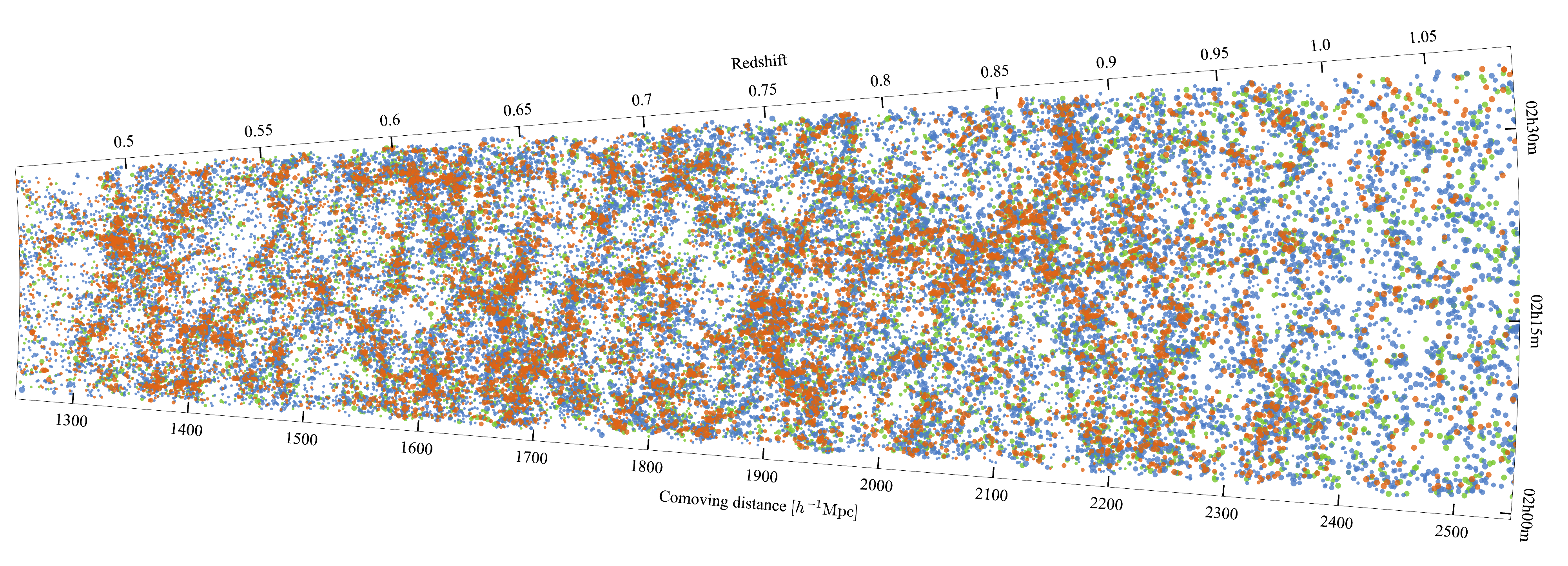The last three decades of cosmological observations and discoveries led to the establishment of a concordance cosmological model. The most revolutionary discovery (1998) was that the Universe expansion is accelerating, requiring the inclusion of the so-called cosmological constant in Einstein’s equations. According to such successful “standard” model, most of the matter in the Universe is not made of the particles we know on Earth, but of some sort of ‘dark matter’, yet to be identified. In this scenario, the galaxies and the large-scale structures they form today (see figure) are thought to originate from the gravitational growth of some initial perturbations of quantum mechanical origin.

Figure 1. The large-scale distribution of about 60.000 galaxies, in a “slice of the Universe” mapped by the VIPERS survey. VIPERS was built by an international team coordinated by our group using the ESO Very Large Telescope to measure galaxy distances. In this figure, each dot corresponds to a galaxy, with size proportional to its B-band luminosity and colour reflecting the intrinsic U-B colour of the object
The cosmological physics group at UniMI originates from an Advanced Grant of the European Research Council (ERC) awarded in 2012 to support the Darklight project (P.I. L. Guzzo). Darklight entailed the analysis of new galaxy survey data, as in particular from the VIPERS survey (Figure 1), through advanced statistical and modelling techniques. This work continues today, combining simulations and theoretical tools to extract cosmological information from state-of-the-art observations of the large-scale structure of the Universe. Members of our group are involved in the two major current endeavours in this field, i.e., the DESI and Euclid projects. While the ground-based DESI redshift survey is ongoing at full steam and already collected more than 30 millions of galaxy redshifts, the ESA Euclid satellite has been launched in July 2023 and its first data release will take place in October 2026. As founding member of the Euclid collaboration, with primary responsibility in the overall scientific coordination of the mission, our group will have a leading role in the analysis and validation of the galaxy clustering data.
Projects like DESI and Euclid and their combination with future CMB observations will allow us to address the fundamental open questions currently casting doubts on the standard model:
> What is the origin of the accelerated expansion of the Universe? Is it a simple cosmological constant or a more complicated form of Dark Energy or is it signaling a failure of the theory of gravity on the largest scales?
> What is the particle nature of dark matter? How strong can it interact with our more familiar matter?
> Can we use large-scale structure observations to measure the mass of fundamental particles such as neutrinos?
> How can we test the nature of the initial condition of our Universe? Was there an inflationary phase which seeded the structure we see today?
> What is the origin of galaxies? Was there a very early accelerated phase, known as inflation, which seeded the structures we see today?
Members:
FACULTY:
POSTDOCS:
> Martin Kärcher
> Iñigo Sáez Casares
> Pierre Zhang
PhD STUDENTS:
AFFILIATED FACULTY AND POSTDOCS:
> Carmelita Carbone (staff INAF-IASF)
> Benjamin Granett (staff INAF-OA Brera)
> Andrea Pezzotta (postdoc INAF-OA Brera)
Former members (at UniMI):
> Marina Cagliari (PhD student)
> Marco Bonici (postdoc)
> Faizan Gohar Mohammad (postdoc)
> Adam Hawken (postdoc)
> Andrea Pezzotta (PhD student)
> Emiliano Sefusatti (INAF Faculty, OABrera)
> Federico Tosone (postdoc)
> Matteo Zennaro (PhD student)